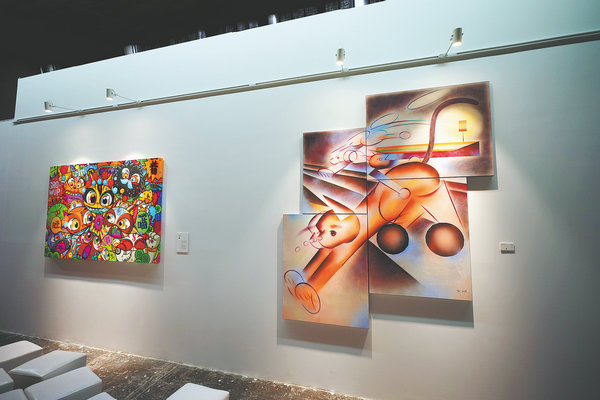

There is an exhibition hall themed around Ukiyo-e, a type of Japanese woodblock printing popular during the Edo period (1603-1867), which offers insight into the unique status of cats in Japan. A mock Japanese izakaya, or tavern, has been built for visitors to chill and take pictures with cartoon-style animals.
Drawing inspiration from the 12th-century scroll painting Along the River During the Qingming Festival, the exhibition hall's corridor has been transformed, with the aid of video, into an ancient bustling city, where cats wander through the market, adorning people's lives with their presence.
The exhibition also introduces a series of contemporary works created using various art forms, such as sculpture and new media. With modern understanding, cats are presented as multiple incarnations of concepts, emotions, symbols and beliefs.
Ke Da, 38, who has been raising cats for over a decade, created an oil painting titled You, Me, It.
"The inspiration for the art piece comes from my experience living with cats and feeding stray cats in the neighborhood. Painting cats is like describing a close family member to me," Ke says.
The artist reveals that the creation process took about a week.
"When I decided to portray stray cats, there wasn't a specific image in my mind. … I see them as a group rather than individuals, and I couldn't express my feelings by focusing on one particular cat," he explains.
"They have their own world, intersecting with our world for only several minutes from time to time. Therefore, the artwork is created in a fragmented style, ultimately forming the image of a cat."
For the first layer of the background, he uses blue to represent the sky, yellow to represent reality, and green to signify nature. The background of the painting is abstract, preparing the environment for the appearance of the stray cats.
For the second layer, he cuts out some fabric and collages some abstract human shapes onto the canvas.
"The first layer represents the real world, while the second layer represents human traces of life. Once this environment is set up, all that's left is to wait for the stray cat to appear. I like to call this process 'finding'. Finally, the cat is outlined, or rather, found. Thus the artwork is completed," Ke says.